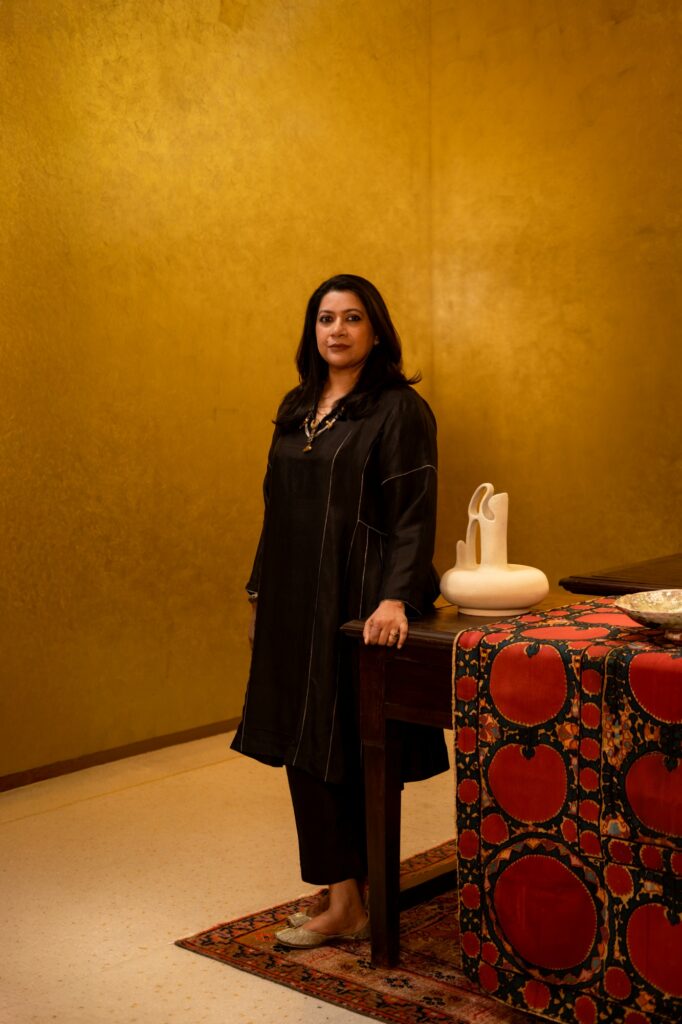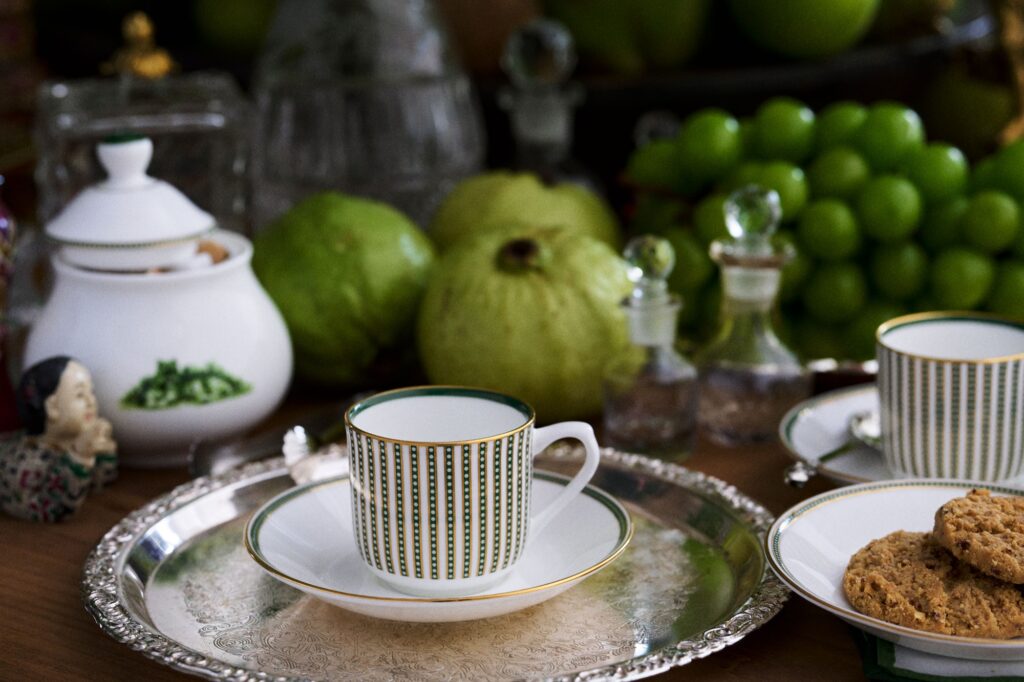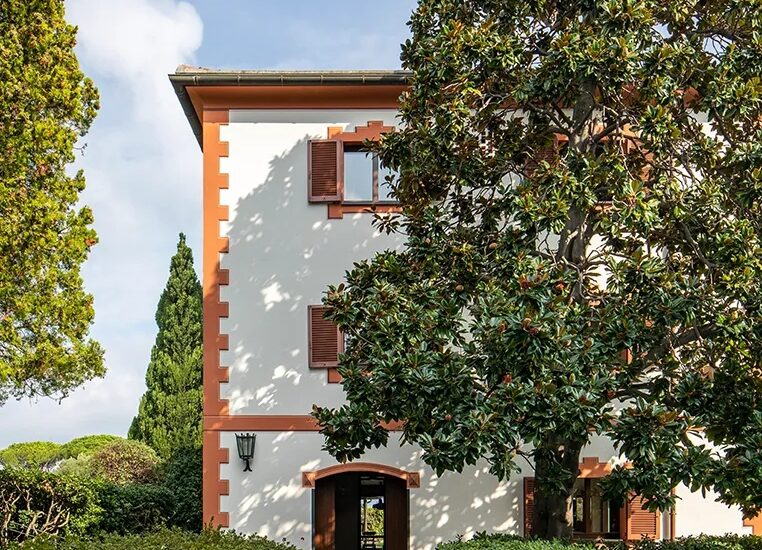Sabyasachi’s Tableware for Nilaya Anthology Reimagines Luxury
Celebrated Indian designer Sabyasachi Mukherjee, long admired for his deep-rooted storytelling, monumental textiles, and maximalist visual language, has turned his attention from couture to the world of home decor. His latest creative chapter arrives through a striking collaboration with Nilaya Anthology, resulting in his first-ever tableware collection, a striking 16-piece series titled Bengal Tigris.
 Launched exclusively at Nilaya Anthology in Mumbai, the design studio and retail destination helmed by Pavitra Rajaram, the collection is already being spoken of as a defining moment for contemporary Indian design. It is not simply a set of plates and serving pieces. It is a crafted narrative woven from memory, ecology, art, and the ineffable charm of old Calcutta.
Launched exclusively at Nilaya Anthology in Mumbai, the design studio and retail destination helmed by Pavitra Rajaram, the collection is already being spoken of as a defining moment for contemporary Indian design. It is not simply a set of plates and serving pieces. It is a crafted narrative woven from memory, ecology, art, and the ineffable charm of old Calcutta.
 Nilaya Anthology, with its curated sensibility, has become a cult name in South Asian design since its opening. Spread across 100,000 square feet in Mumbai, the studio positions itself as a living archive of Indian design languages, reinterpreted for a new generation.
Nilaya Anthology, with its curated sensibility, has become a cult name in South Asian design since its opening. Spread across 100,000 square feet in Mumbai, the studio positions itself as a living archive of Indian design languages, reinterpreted for a new generation.

The mastermind behind Nilaya Anthology, Pavitra Rajaram.
For Pavitra Rajaram, this reinterpretation lies at the core of Anthology’s vision. “Design is never about creating in isolation. It’s about connecting,” she says. “Every collection begins with a story rooted in cultural memory — asking who we are, where we come from, and how we live today.”

The curated interiors of Nilaya Anthology.
This ethos made Nilaya Anthology the natural home for Sabyasachi’s debut tableware line, merging his maximalist world with Anthology’s softer, distilled expression of luxury.
Inspired by the Sunderbans
 “Bengal Tigris” draws its inspiration from the “lush wetlands of the Sunderbans”, home to the majestic Bengal tiger and one of the subcontinent’s richest ecological biomes. Each plate and bowl is based on original watercolour paintings by the Sabyasachi Art Foundation, then hand-decorated on fine bone China and embellished with 24-karat gold.
“Bengal Tigris” draws its inspiration from the “lush wetlands of the Sunderbans”, home to the majestic Bengal tiger and one of the subcontinent’s richest ecological biomes. Each plate and bowl is based on original watercolour paintings by the Sabyasachi Art Foundation, then hand-decorated on fine bone China and embellished with 24-karat gold.
The result is a series that feels nostalgic yet contemporary, opulent yet restrained. Verdant greens unfurl across ivory backdrops, unfolding like scenes from a forgotten travel journal.
“It brings together the artistry of the Sabyasachi Art Foundation and the historical richness of Calcutta’s genteel past,” Pavitra explains. “Every piece transforms everyday dining into a narrative of art and nostalgia.”
A Dialogue Between Two Design Worlds
 Behind the collection is a shared vision between Sabyasachi’s studio and Nilaya Anthology, one that celebrates the craft traditions of India while reframing them for a global audience.
Behind the collection is a shared vision between Sabyasachi’s studio and Nilaya Anthology, one that celebrates the craft traditions of India while reframing them for a global audience.
“Our collaboration is rooted in the language of craft,” Pavitra says. “His world celebrates the lush, layered beauty of India; ours is about reinterpretation, distilling that richness into something timeless.”
Sabyasachi’s Art Foundation brought the flora and fauna of the Sunderbans to life through exquisite watercolour illustrations. Anthology’s design team then translated these into the material vocabulary of fine China. The result is a collection that sits somewhere between painting and product, intimate, contemplative, and quietly luxurious.
Far from being just functional objects, “Bengal Tigris” is designed to recreate a world, one that is all about Calcutta’s old-world charm. The collection evokes the experience of a table set in crisp linens, surrounded by oriental lilies, crystal goblets, and flickering candles, while outside the air is thick with honeysuckle and the warm breeze of a Bengali night.
“Dining, at its best, is ritual,” Pavitra reflects. “When art, design, and storytelling merge at the table, the experience becomes immersive. In Bengale Tigris, every motif, every stroke of gold tells a story, of wetlands, craftsmanship, and heritage.”
This sensorial storytelling repositions Indian tableware not as decorative exotica, but as an expression of global sophistication grounded in place, ecology, and inheritance.
Reframing Indian Luxury for the World
 Beyond its visual splendour, “Bengal Tigris” signals a broader shift. As India’s design ecosystem matures, collaborations like this challenge old narratives that cast Indian design as merely “ethnic” or “decorative.”
Beyond its visual splendour, “Bengal Tigris” signals a broader shift. As India’s design ecosystem matures, collaborations like this challenge old narratives that cast Indian design as merely “ethnic” or “decorative.”
“Indian design can be both rooted and globally resonant,” Pavitra emphasises. “It’s about taking something deeply local, a Calcutta night, a tiger in the mangroves, and presenting it with a quiet, modern sophistication that speaks everywhere.”
For international audiences, the collection offers a refined entry point into Indian craft traditions, not as exotic spectacle, but as contemporary cultural expression.
Craft, Memory, and the Future of Indian Design
 Nilaya Anthology has long championed Indian artisanship, especially craft forms at risk of fading. “Luxury, to us, is cultural,” Pavitra says. “It lies in the human hand, the imperfect brushstroke, the story that takes generations to tell.”
Nilaya Anthology has long championed Indian artisanship, especially craft forms at risk of fading. “Luxury, to us, is cultural,” Pavitra says. “It lies in the human hand, the imperfect brushstroke, the story that takes generations to tell.”
By giving these techniques new relevance in modern design contexts, Anthology preserves knowledge while ensuring economic sustainability for the craftspeople behind it.
Looking ahead, the studio aims to expand its narrative-building across textiles, ceramics, and furniture — always anchored in authenticity and craftsmanship.
While “Bengal Tigris” is distinctly Indian in its inspiration, its appeal is universal. “There’s a universal longing for travel through memory and sensory landscape,” Pavitra notes. “The collection offers a glimpse into India as a sophisticated cultural voice: confident, rooted, and relevant on the world stage.”
In this way, Bengal Tigris becomes more than a collection. It becomes a cultural ambassador, a reminder that Indian design, when grounded in its own heritage, speaks a language the world is ready to listen to.
Where to Find It
 Bengal Tigris is available exclusively at Nilaya Anthology, Mumbai, the design destination curated by Pavitra Rajaram. For collectors, design enthusiasts, and those drawn to the layered beauty of Indian craft, this collection signals a new era of Indian luxury one defined not by opulence, but by storytelling, artistry, and memory.
Bengal Tigris is available exclusively at Nilaya Anthology, Mumbai, the design destination curated by Pavitra Rajaram. For collectors, design enthusiasts, and those drawn to the layered beauty of Indian craft, this collection signals a new era of Indian luxury one defined not by opulence, but by storytelling, artistry, and memory.
All Images Courtesy Nilaya Anthology.




